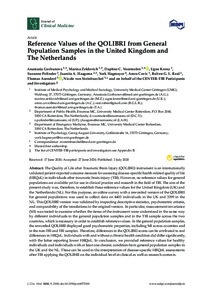Reference Values of the QOLIBRI from General Population Samples in the United Kingdom and The Netherlands
Gorbunova A; Zeldovich M; Voormolen DC; Krenz U; Polinder S; Haagsma JA; Hagmayer Y; Covic A; Real RGL; Asendorf T; von Steinbuechel N; CENTER-TBI Participants and Investigators
Reference Values of the QOLIBRI from General Population Samples in the United Kingdom and The Netherlands
Gorbunova A
Zeldovich M
Voormolen DC
Krenz U
Polinder S
Haagsma JA
Hagmayer Y
Covic A
Real RGL
Asendorf T
von Steinbuechel N
CENTER-TBI Participants and Investigators
MDPI
Julkaisun pysyvä osoite on:
https://urn.fi/URN:NBN:fi-fe2021042825664
https://urn.fi/URN:NBN:fi-fe2021042825664
Tiivistelmä
The Quality of Life after Traumatic Brain Injury (QOLIBRI) instrument is an internationally validated patient-reported outcome measure for assessing disease-specific health-related quality of life (HRQoL) in individuals after traumatic brain injury (TBI). However, no reference values for general populations are available yet for use in clinical practice and research in the field of TBI. The aim of the present study was, therefore, to establish these reference values for the United Kingdom (UK) and the Netherlands (NL). For this purpose, an online survey with a reworded version of the QOLIBRI for general populations was used to collect data on 4403 individuals in the UK and 3399 in the NL. This QOLIBRI version was validated by inspecting descriptive statistics, psychometric criteria, and comparability of the translations to the original version. In particular, measurement invariance (MI) was tested to examine whether the items of the instrument were understood in the same way by different individuals in the general population samples and in the TBI sample across the two countries, which is necessary in order to establish reference values. In the general population samples, the reworded QOLIBRI displayed good psychometric properties, including MI across countries and in the non-TBI and TBI samples. Therefore, differences in the QOLIBRI scores can be attributed to real differences in HRQoL. Individuals with and without a chronic health condition did differ significantly, with the latter reporting lower HRQoL. In conclusion, we provided reference values for healthy individuals and individuals with at least one chronic condition from general population samples in the UK and the NL. These can be used in the interpretation of disease-specific HRQoL assessments after TBI applying the QOLIBRI on the individual level in clinical as well as research contexts.
Kokoelmat
- Rinnakkaistallenteet [27094]
